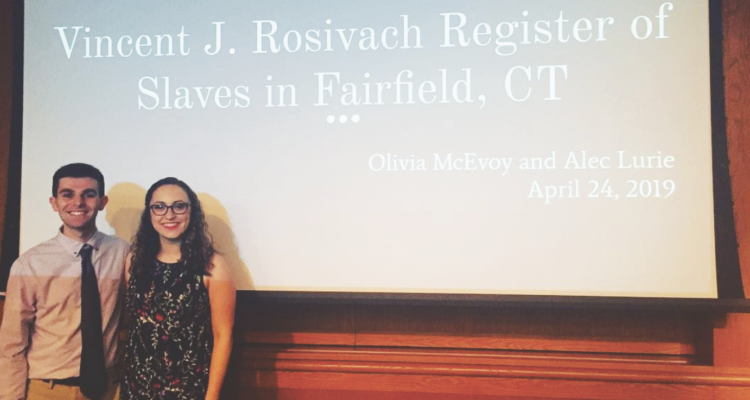Students Olivia McEvoy ‘19 and Alec Lurie ‘19 carried on the legacy of the late Vincent Rosivach Ph.D., as they presented the work the three had done to document the history of slavery in the town of Fairfield. The two students presented their findings, methods of research and culminating database in the Dimenna Nyselius library multimedia room on Wednesday, April 24.
One goal of the project was to highlight the presence of slavery in Fairfield, a topic of which many might be unaware. “I think one of the best parts of the project that the impact that it has on the town of Fairfield,” said McEvoy via email.
“In general, there are so many misconceptions about Northern slavery, and many people tend to forget that slavery was as widespread an institution in the North as it was in the South. This, coupled with the fact that so much of the information about a particular slave in Fairfield could be spread across 5-6 separate documents, means that our work is really bringing to light a narrative so hidden away in our previous studies of the past.”
The Fairfield Slavery Project was a large part of Rosivach’s work before he passed away on April 13, 2018. His tenure at Fairfield University lasted 53 years. According to the Fairfield University website, “For 53 years, [Rosivach] dedicated his life to fostering the minds of his students, inspiring fellow professors, and embracing what it means to teach at a Jesuit institution. Over the course of his professional career, he immersed himself in literature and education and inspired others to do the same. He authored two books in addition to more than 120 articles and reviews within the field of classics.”
The culmination of the work is a database that contains information on former slaves and slave owners, or “households,” as the project calls them, that resided in the town of Fairfield. This database will reside on the DiMenna Nyselius website, where it can be accessed by Fairfield University students and faculty. A reception followed the presentation, in which guests were welcome to explore the database.The project and the database appear to open the eyes of those who interact with it.
“Since the launch of our site, there have been numerous people who have told Alec and I that their perspectives on Fairfield have begun to change,” said McEvoy. “Whether it being more cognizant of the fact that there were instances of slavery in this town, or if they are more aware of the history of many of Fairfield’s most famous residents (many of whom were slave owners), I think that our project is generation necessary conversation about our understandings of the past.”
This sentiment was clearly felt by those in attendance for the presentation. “This work will have [a] lasting impression on how members of the Fairfield community view their town,” wrote Anna Kamradt ‘19, who was in attendance.
“Cataloging slaves in this nature is the beginning of a wave in specific individuals who might’ve been previously overlooked now find their stories told and preserved. I can’t wait to see how this work inspires other projects in the future. Dr. Rosivach would have been so proud.” McEvoy and Lurie also presented this information the following day, April 25, at the annual Innovative Research Symposium.
In terms of the future of the project, Lurie and McEvoy are hopeful that their work can be continued. “ This research can never truly be done because there are definitely instances where slaves were not recorded by their owners, and are therefore lost to our records forever,” concluded McEvoy.
“The next student to take on the project has an equal amount of autonomy to figure out what to do next, as they can focus on whatever aspect of life in Fairfield relating to slavery they would like.”


Leave a Reply